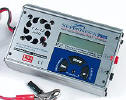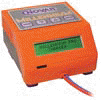|
|
|
CHARGING |
|
The maximum current rate (in Amps) that the cells can charged or discharged at. Exceed this value ie, shorted out, fast charged too fast or too long and the cells life is reduced or they could blow up. An indication of over charging is when you see the same battery pack you've just bought half the price in another model shop! Sorry back to the point, overcharging causes the cells to overheat and vent off gases through the top indicated by a fizzing noise. If this happens, switch everything off, disconnect the batteries and run!! You will have certainly shortened the life and reduced the AH capacity if you haven't destroyed them entirely. |
     |
| FAST CHARGING :- |
|
Some
modellers want their batteries charged as quickly as possible and
forcing as many Amps into the cells as possible, this is known as
fast charging. There are lots of cheap fast
chargers around with a clockwork timer that stops
charging after the set time expires. These
chargers have the tendency to either under or overcharge your
cells as they don't employ any method of checking the
charge level of the cells. A better way of fast charging
is to use an automatic charger. The best types are 'peak
detection' chargers. |
| PEAK CHARGERS |
|
These
chargers
accurately monitors the cell pack voltage
and then automatically stops charging when the
cells reach the set voltage which corresponds to maximum
charge. The temperature of cells rises in relation to the
amount of current flow in to of the cells, so a THERMAL CHARGER
has a temperature sensor, called a thermistor, that measures the cells
temperature and automatically shuts off when the cells reach
the temperature corresponding to full charge. The thermistor MUST
remain in contact with cells because if it falls off the charger
may just keep charging. The instructions
with the thermal charger will state what the full charge
temp should be, on some it's adjustable. A separate digital
monitor with probe can also be used to check the temperature of the
cells whilst using a clockwork charger but obviously
you'll need to manually switch off the charger
when the full charge temp is reached.
There are a lot of good automatic chargers around,
some relativity cheap, others featuring
digital meters, cycling circuits and computers, others
sing, dance and make the tea. Make sure you don't
pay for gimmicks that you don't need. |
| TRICKLE CHARGERS |
|
|
|
Did you know that you can't fully re-charge your nicads? When you have used your nicads, they are not completely discharged, some charge still remains. As nothing is 100% efficient, lets say your cells are only 98%, efficient, that means that the cells will only accept 98% charging of the discharged space, you'll lose 2%. With every succeeding partial charge / discharge cycle, your cells could loose another 2%. It's then easy to see that after 10 cycles your cells could be down as much as 20% of their full capacity. This is why you see some modellers completely discharging their battery packs with a car headlamp bulb connected to the cells, (a 15 ohm 10 watt resister with a 12v car side light bulb across the cells would be less stressful). This ensures that all the cells are discharged evenly down to nothing so allowing them to be fully fast charged to, in our case 98%, you only loose the same 2% every re-charge. Most people agree it's best to leave the cells discharged for storage and only charge them as required. The new NicalMetal Hydrides Cells don't suffer from this problem. |
|
Transmitter (Tx) and receiver (Rx) nicads aren't worked very hard and are always trickle charged so should only need to be fully discharged once a year at most by leaving the transmitter and receiver on at home. Re-charge them and make sure they are all OK on a meter. Cells can be checked on an meter set to volts then Amps, dodgy cells will have a lower voltage and current reading than the rest. Take the current readings on a setting of 20-30 Amps range and as quick as possible as you are actually shorting the cells. This test can be done on the main sub-C cells BUT ONLY ONE AT A TIME AND VERY QUICKLY. If in doubt - Don't!
Well all of this is just my opinion, but what the hell do I know! |